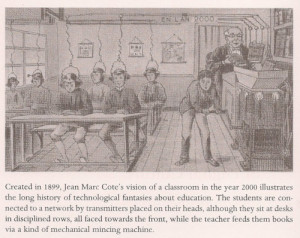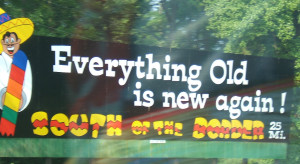“We can equate the place with geometry and space with geography. Geography or space is lived or practiced more than geometry of place … geometries are necessary ways of mapping relations among histories and constructing tactics of resistance that tie local to global concerns” (141) – Johnson-Eilola Nostalgic Angels
First, let me say Gregory Bateson‘s philosophical treatise reminded me of several of our recent theorists (naturally). Secondly, I found his reference to Korzybski that “the map is not the territory” (455) especially interesting. I don’t think I’ve plumbed all the potential of that concept, but I do know the first thing I thought of was the distinction by Johnson-Eilola (J-E) on geometric vs. geographic space (in Nostalgic Angels) and that “[c]ommon sense tells us not to confuse the colored lines on paper maps with reality” (15). However, J-E also points out that “maps certainly participate in the real activities, suggesting and authorizing ways of living – maps are part of reality” (15). So I wonder: how would Bateson respond to Johnson-Eilola’s argument that “the borders of discourse formations are real practices and structures” (15)? I rather suspect there would be some agreement, as Bateson’s article is all about perception and ways ecologies and borders and “minds” are functioning within a system (465). But there is so much packed into a relatively small space (and I’m still trying to figure out if that’s at all related to the comment about LSD in the conclusion) that I felt as though I was only able to grab onto a small piece. In this case, it is his concept of mapping and “worlds of explanation” of that mapping: the physical cause-effect world of the “pleroma” and the idea world of the “creatura” in which “effects are brought about…by difference” or ideas. Where those two meet — the “bridges which exist between those two worlds” (Bateson 462) — however, seems to hinge on perception.
It seems that Bateson wants us to see maps with an eye toward layering in “abstract…philosophic thought” (454) when he addresses the related question, “what is the territory?” He claims “the process of representation [by viewpoints or measurements] will filter [the territory] out so that the mental world is only maps of maps of maps… All ‘phenomena’ are literally ‘appearances’” (460-1). So if Johnson-Eilola’s borders are included in a map (as they surely must be), would Bateson’s theory of affordances when framed this way be a challenge to that concreteness? I am not sure it would, as I think J-E is also arguing for the role of perception of “borders” of a “landscape” that we actually “construct and maintain” – Bateson’s world of the creatura, perhaps. Yet it also seems J-E is arguing for borders that are the manifestations of “social forces” that are made visible at those “nodal points” of the border (16)… which reminds me of Bateson’s statement that we must “look at the bridges which exist between these two worlds” of pleroma and creatura in order to perceive the system (462). And as he asserts, if we “want to explain or understand anything in human behavior,” including the networks we inhabit and construct, then we must understand in terms of “completed circuits” – differences in perceptive agencies, whether it is “the cut face of the tree” or the visual cortext fed by the axe man’s retina (465). Could this be what our professors are referring to as “distributed consciousness”?
Then there is the subject of “affordances.” I must say, this is a concept for which I can see all sorts of deep-pool potential for my OoS (MOOCs). Gibson confesses that he simply made up this term (127), but I find his definition of the concept powerful. The connection to Bateson is in terms of relationships (455) – but Gibson puts this in somewhat less physio-psycho terms analogous to “the communication system of the body” (467). Such framing certainly seems appropriate given the cyborg nature of some of our network models. Gibson’s Theory of Affordance is designed to provide us with a “new definition of what value and meaning ARE” (140), something I think Norman qualifies productively in his string of design examples that focus on physical constraints and perceived vs. actual affordances. In truth, I think Norman’s article is the one that really clarified the application of this theory, while Gibson and (more so) Bateson lingered just a little too long in the ethereal domain for someone like me who is all about the practical application. Be that as it may…
For Bateson, there are two types of ecology: (1) bioenergetics or “units bounded at the cell membrane” for which “boundaries are…the frontiers” (466), which made me think of borders as nodes of multi-directional agency (Latour’s many-spoked nodes as illustrated by Dr. Romberger), a jumping off place. Then there are (2) economies of information – “boundaries as enclosing pathways” (467). Does “enclosing” mean limitations? Drawing the line “here, and no farther”?
At first, I thought of Latour and ANT when I started reading, thinking that these borders, relationships, and ecologies were mutually influential and equally capable of agency. But when reading Gibson’s claim that (129) “[a]n affordance points…to the environment and to the observer,” I wondered – since so much of this theory is about perception – is Gibson limiting (or privileging) this theory to the perceptions of the human observer? Norman points to perceived vs. real affordances in terms of designers and users (echoing Spinuzzi), but would this be the same as those “separations between ‘self’ and ‘experience’” about which Gibson cautions (469)? Gibson certainly puts the animal / material world on what seems like a subordinate level – something to be acted upon or damaged – so how would this stack up against a Latour or Spinuzzi and Actor-Network Theory?
As I mentioned earlier, the concept of affordances as a means of expressing the physical as well as value-laden conditions of the network – especially in terms of online learning – seems to promise an interesting theory for my OoS. If I can just figure out how to align all these borders… 
References
Bateson, Gregory. Steps to an Ecology of Mind. New Jersey: Jason Aronson Inc., 1987.
Gibson, J. J. “The Theory of Affordances.” In R. E. Shaw & J. Bransford (Eds.), Perceiving, Acting, and Knowing. Hillsdale, New Jersey: Lawrence Erlbaum, 1977. pp. 127-143.
Johnson-Eilola, Johndan. Nostalgic Angels: Rearticulating Hypertext Writing. Norwood, NJ: Ablex Publishing, 1997.
Norman, Don. “Affordances and Design.” jnd.org. 2004. Web.





